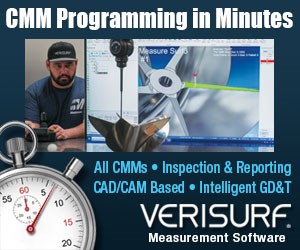ADDITIVE MANUFACTURING

3D printing, or additive manufacturing, simplifies the moldmaking process by making mold inserts, mold components, end-use parts, and ancillary equipment.
Narrow by Additive Manufacturing Product Category
-
Additive Manufacturing Machines
- Additive Manufacturing Machines for ceramic parts
- Additive Manufacturing Machines for composite parts
- Additive Manufacturing Machines for metal parts
- Additive Manufacturing Machines for polymer parts
- Additive Manufacturing Machines—Binder Jetting
- Additive Manufacturing Machines—Directed Energy Depostion
- Additive Manufacturing Machines—Material Extrusion
- Additive Manufacturing Machines—Material Jetting
- Additive Manufacturing Machines—Powder Bed Fusion
- Additive Manufacturing Machines—Sheet Lamination
- Additive Manufacturing Machines—Vat Polymerization
- Hybrid Additive-Manufacturing Machines
- Material
- Material Handling Equipment for Additive Manufacturing
FAQ: Additive Manufacturing
What are the use cases of additive manufacturing in moldmaking?
Additive manufacturing (AM) of metals is gaining market acceptance with specific use cases, including some workflow examples in moldmaking such as building up components with conformal cooling channels, printing expensive metals for less waste, or performing repair work to extend the life of production molds.
When it comes to the "big picture" view of AM, there are two approaches to moving the deposition head: flatbed (or planar) and multi-axis. Flatbed is the most common method used on printers ranging from inexpensive home 3D printers to large industrial metal laser sintering systems. When using the flatbed approach, parts are nested in a work envelope, and slicing is always planar—usually perpendicular to the Z-axis—and completed in that one direction.
The multi-axis approach deposits material in directions, compared to just one vector or direction. The print head of these systems is mounted inside a five-axis CNC machine or mounted onto a robot. They are referred to as hybrid multi-axis additive machines and can perform both additive and subtractive operations.
(Source: Five Key Aspects of a Basic Multi-Axis AM Programming Workflow and CAD/CAM/AM Tools)
Is 3D printing cost effective for moldmaking?
According to Matt Sand, president of 3DEO, a California-based metal AM parts supplier, there are three things to consider when determining whether it will be cost-effective to 3D print a given part:
1. Part Size
Is it bigger/smaller than a golf ball? One thing Sand has learned over the last few years is that as part size increases, the cost increases on an exponential curve.
Smaller (golf ball-sized) parts manufactured traditionally are price competitive. However, as the part size starts to reach softball size and greater, the cost skyrockets. It’s not uncommon in laser sintering for very large parts to cost $20,000 or more.
2. Assembly
Is the cost of assembly less than the cost of printing a consolidated part? Sand believes there is often a disconnect from reality when it comes to parts consolidation. “For example, a customer wants a five-piece automotive assembly printed as one piece. What they typically overlook is that the cost of the individual components and assembly is still very low,” he says. “The total cost of the metal 3D-printed part needs to be less than the total cost of the assembly. Given consolidated assemblies are large, it’s usually much more expensive to print versus assemble.”
3. Complexity
Does the part have complex features like conformal cooling, and is it likely to require substantial postprocessing? Conformal cooling is a hot trend in additive manufacturing, but 3DEO tries to be realistic with interested customers. The reality is that high-value tools are the best fit, because when it comes to laser sintering (the most common method used to make conformal cooling channels) the cost is high and the after-print surface finish still needs postprocessing.
(Source: When Is 3D Printing Cost Effective?)
How do moldmakers determine the quality of a plastic injection mold when 3D printing?
Here are two critical factors for determining the quality of a plastic injection mold and how AM fits into the mold build process to help meet and exceed these quality standards:
1. The mold's ability to quickly and consistently produce quality parts in conjunction with conformal cooling.
AM involves designing conformal cooling channels, unlike anything that a shop can produce with subtractive machining. Using AM, a mold builder can design conformal cooling channels that hug the contour of the part surface, eliminating hot and cool spots in the parts and reducing the risk of distortion. On top of that, using computer simulation software simplifies identifying the proper location for the cooling lines.
Removing the heat from the mold as quickly as possible is the key to reducing the amount of time the part must remain in the mold. Cooling line placement is one part of the equation. The other part is the steel’s ability to cool the mold, also known as thermal conductivity. Several mold material producers offer materials with high thermal conductivity (HTC).
2. The mold's strength and toughness at elevated temperatures.
This determines how long the mold will be able to run before downtime for maintenance is necessary. Strength goes together with hardness, which is determined primarily by the carbon content. However, high carbon content is where printability becomes an issue because higher carbon content can lead to cracking, reducing mold life.
AM is a combination of melting and heat treating that is impossible in traditional wrought operations. For example, laser powder bed fusion (L-PBF) is an AM process for building molds. It is a series of layer-by-layer melting of powder via a laser with subsequent gas cooling. Phase transformation occurs in this cooling, which, if not controlled, can lead to cracking.
However, today there are newly developed AM materials designed to reduce the carbon content, which prevents cracking but maintains acceptable mold hardenability. The toughness of these new AM materials is proving superior to the conventional material at the same hardness, which results from superior melting and processing to produce the powder and the subsequential microstructure available for AM parts.
(Source: Exploring AM Powders for Tooling)
How do moldmakers use hybrid additive manufacturing?
A hybrid AM part is a traditionally manufactured base geometry upon which material is added using various additive technologies. A common AM application in moldmaking is repairing old or worn molds—building up worn areas of a mold or adding new features to an old mold.
Different AM processes provide benefits to these applications. For example, directed energy deposition (DED) makes sense for most repair applications that need to build material back up. Powder bed fusion (PBF) is better suited for adding new features to an old mold, such as cooling channels or venting.
Most DED technologies follow the mold’s 3D surface, adding consistent, even layers to the worn areas of the mold, providing a more controlled heat affected zone (HAZ). Shops can then machine these areas back to the required shape, dimensions and tolerances.
The most common DED systems used in mold repair include a DED laser head and powder/wire delivery system built into a CNC system. This setup streamlines the process by requiring the shop to set up the worn mold in the system once, machine the rebuilt surfaces to yield a clean, even surface and then add material to build up these regions before final machining.
(Source: How to Use Hybrid Additive Manufacturing)
How can moldmakers improve 3D-printed conformal-cooled mold insert performance?
3D-printed molds with conformal cooling channels yield more efficient heat transfer, but the geometrically intricate channels may increase the likelihood of scaling. Scaling decreases flow and worsens the integrity of the cooling channel walls, which leads to leaking.
Maintenance solutions for eliminating scaling and corrosion range from cooling channels flushing with aggressive cleaning media that can damage the mold, to gentler ultrasonic cleaning that may be ineffective. Shops also opt to fix leaking cooling channels, which has high costs and downtime, and, in many cases, is not possible.
Another option for combating scaling and corrosion is to coat the inner diameter of the cooling channels. Most mold builders and parts manufacturers are familiar with electroplating or PVD coating mold surfaces to increase hardness and to extend mold life, but many do not realize that a surface treatment to the inner cooling channels will improve the lifespan of a mold’s interior as well.
Applying a thin layer of internal, ultra-thin, thermally conductive ceramic coating can provide several benefits that ultimately prolong the lifespan of the cooling channels, provide better uptime and save an injection molder money. The coating is thin enough (50-100 microns) that it has no measurable effect on heat transfer.
(Source: How to Improve 3D-Printed Conformal-Cooled Mold Insert Performance)
How does a moldmaker choose the right cutter for hybrid additive manufacturing?
Four ways to apply the right cutting tools in hybrid additive manufacturing are:
- Ball-nose and radius end mills with a special neck design, cutting edge contour and coating are good choices. A pre-milling end mill with ball-nose geometry targets roughing and pre-finishing operations in order to produce a specific machining allowance on the additively manufactured component. The machining direction here is from top (Z+) to bottom (Z-).
- A finishing cutter, also with ball-nose geometry, is recommended for finishing operations in construction layers no longer subject to thermal stress. The cutting area of the tool should be designed so that pull machining from bottom (Z-) to top (Z+) is possible in order to finish the material layers that are no longer thermally stressed.
- A "back taper" radius end mill is suitable for 2D machining of undercuts on the component. Its specifications are aimed at pre-finishing and finishing applications on additively produced components.
- Some hybrid additive manufacturing applications may require solid carbide micro end mills that are designed to meet the unique and demanding requirements of micro machining applications. In this case, micro end mills with a specific neck geometry enable the optimal application of these tools even in deep contours. A high radial bending strength allow the tools to withstand alternating radial stress on the cutting edge and on the relieved neck during the machining process. A newly developed ALCR coating provided exceptional wear resistance for long tool life.
(Source: Cutter Considerations for Hybrid Additive Manufacturing
How does a moldmaker know which 3D printing technology to use?
With AM, it is possible to address a wide range of moldmaking needs from printing entire molds or inserts (often with powder bed fusion/PBF or vat photopolymerization) to localized repair or hardface welding of mold surfaces (often with directed energy deposition/DED). In moldmaking, these use cases ultimately translate into improvements to lead time, cycle time and lifetime.
(Source: The Mold Builder’s Guide to Additive Manufacturing & Hybrid Manufacturing Technologies)
Get Listed!
Thousands of people visit this Supplier Guide every day to source equipment and materials. Get in front of them with a free company profile.










